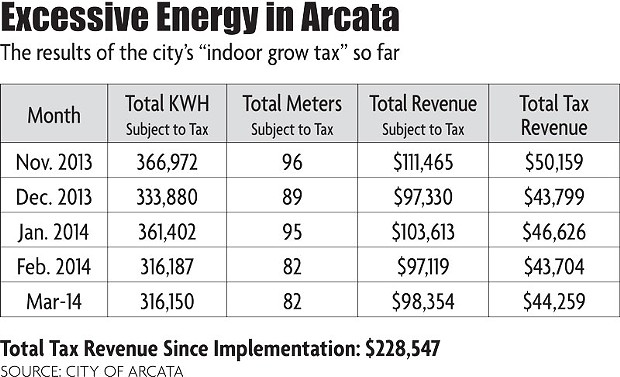[
{
"name": "Top Stories Video Pair",
"insertPoint": "7",
"component": "17087298",
"parentWrapperClass": "fdn-ads-inline-content-block",
"requiredCountToDisplay": "1"
}
]
It's been seven months since Arcata's excessive electricity tax went into effect, and the threat to residential growers' bottom lines seems to have sent most of them packing.
The results are drastic. In the year or so between city residents' approval of the tax and implementation, the number of houses using "excessive" energy dropped from 633 to just 82 in March. With that result, and municipal fears that growers will simply set up shop in McKinleyville, Eureka or other unincorporated parts of the county, other local governments are considering similar taxes.
The city conceived of the tax ostensibly to reduce greenhouse emissions and bring it into compliance with state energy policy — but they also designed it to deter large residential marijuana grows. Since passage, households that exceed 600 percent of a Pacific Gas and Electric Company baseline must pay an additional 45 percent for every kilowatt hour they use. That baseline is roughly equivalent to three times the usage of a normal residence, according to the city. A 4-by-4-foot indoor grow triples a home's energy usage, according to a study by Lawrence Berkeley National Laboratory researcher Evan Mills. "The added electricity use is equivalent to running about 90 refrigerators."
It appears Arcata's indoor growers got the city's message. "After the first month's figures I was ready to declare victory," Arcata Vice Mayor Michael Winkler said.
Police Chief Tom Chapman more or less agreed. "To the main point, it seems like the high-use tax has been effective," he said. "Has it eliminated [residential marijuana growing]? No. But the egregious, in-your-face, full-conversion grows? Those have seemed to be resolved to some degree. And that has really been the concern for us."
It's still early to declare any trends about grow houses, said Deputy Director of Environmental Services Karen Diemer. "We'd love to have 12 months of data," she said. There are reasons other than "green flight" that might have reduced the number of houses exceeding the threshold.
For one, PG&E, under mounting statewide pressure, announced it would no longer offer the low-income CARE program to households exceeding the same electricity threshold. (That program was subsidized by non-CARE ratepayers.) As part of that switch, PG&E offered assistance to households to bring usage under the "excessive" range.
And growers may have taken it upon themselves to save energy under the threat of a spiking electricity bill.
But Chapman said residential grow houses do appear to be disappearing in correlation with the tax. "The complaints we've received have reduced proportionally to those numbers," he said. "They seem to jive."
Is it just a matter of growers fleeing to more tax-friendly environs?
Chapman said that household grows don't seem to be popping up elsewhere nearby based on anecdotal reports — though he hasn't met with other law enforcement agencies to specifically discuss the tax's effects. He said legalization in Washington and particularly Colorado should be considered when we talk about what's happening to indoor growers. It could be that people are relocating to less expensive and less legally treacherous climes.
Winkler said PG&E reports haven't shown much of an increase in excessive energy households outside of Arcata since the tax was implemented, noting that 8 to 10 percent of households in unincorporated areas are classified as excessive, which is similar to Arcata's pre-tax numbers. Winkler said about 4 percent of Eureka's households exceed the electricity threshold. Eureka and the county are mulling similar taxes.
But the tax also came with an eyebrow-raising $600,000 price tag. Projections based on 2011 statistics saw Arcata making more than $1 million a year from tax revenue, but what happens now that just 13 percent of the exceeding households are paying that tax?
Well, Arcata seems to be doing fine. The city has generated more than $225,000 since November. And even if that income dries up, some council members noted when presenting the tax to voters that the goal was reduction in energy use and residential grows — not a new source of income. Arcata residents, by a two-to-one margin, agreed.
Excessive Energy in Arcata
The results of the city's "indoor grow tax" so far
NOV. 2013
Total KWH Subject to Tax: 366,972
Total Meters Subject to Tax: 96
Total Revenue Subject to Tax: $111,465
Total Tax Revenue: $50,159
DEC. 2013
Total KWH Subject to Tax: 333,880
Total Meters Subject to Tax: 89
Total Revenue Subject to Tax: $97,330
Total Tax Revenue: $43,799
JAN. 2014
Total KWH Subject to Tax: 361,402
Total Meters Subject to Tax: 95
Total Revenue Subject to Tax: $103,613
Total Tax Revenue: $46,626
FEB. 2014
Total KWH Subject to Tax: 316,187
Total Meters Subject to Tax: 82
Total Revenue Subject to Tax: $97,119
Total Tax Revenue: $43,704
MAR. 2014
Total KWH Subject to Tax: 316,150
Total Meters Subject to Tax: 82
Total Revenue Subject to Tax: $98,354
Total Tax Revenue: $44,259
Total Tax Revenue Since Implementation: $228,547
Speaking of...
-

Judge Rules Arcata Can't Put Earth Flag on Top
Apr 5, 2024 -

CHP IDs 2 Adults, Child Killed in 101 Crash
Feb 5, 2024 -

McKinley Statue Rises Again in Canton
Oct 24, 2023 - More »
Comments (2)
Showing 1-2 of 2
more from the author
-
Flamin' Hot's Stale Corporate Propaganda
- Jun 15, 2023
-
Hell is Visiting Other People
- Sep 22, 2022
-
The Bear Roars
- Aug 18, 2022
- More »

































